Projected Convective Storm Environment in the Australian Region from Two Downscaling Ensemble Systems Under the SRES-A2/RCP8.5 Scenarios
Abstract
1. Introduction
2. Methods
2.1. The NARCliM Regional Downscaling System
2.2. Convective Parameters
2.3. Threshold Adjustment
2.4. Statistical Significance and Model Agreement
3. Results
3.1. Projected Changes in Convective Environments
3.2. Change Space in Convective Indices
3.3. Projected Changes in Storm Days
3.4. Seasonal Variations
4. Discussion
5. Conclusions
Supplementary Materials
Author Contributions
Funding
Data Availability Statement
Acknowledgments
Conflicts of Interest
Appendix A
| NARCliM Ensemble Member | Planetary Boundary Layer Physics | Cumulus Physics | Surface Layer Physics | Cloud Microphysics | Shortwave/Longwave Radiation Physics |
|---|---|---|---|---|---|
| R1 | MYJ | KF | Eta similarity | WDM 5 class | Dudhia/RRTM |
| R2 | MYJ | BMJ | Eta similarity | WDM 5 class | Dudhia/RRTM |
| R3 | YSU | KF | MM5 similarity | WDM 5 class | CAM/CAM |
References
- State of the Climate; The Bureau of Meteorology and Commonwealth Science and Industrial Research Organization, Commonwealth of Australia: Melbourne, Australia, 2024; 32p.
- McAneney, J.; Sandercock, B.; Crompton, R.; Mortlock, T.; Musulin, R.; Pielke, R.; Gissing, A. Normalised insurance losses from Australian natural disasters: 1966–2017. Environ. Hazards 2019, 18, 414–433. [Google Scholar] [CrossRef]
- Raupach, T.H.; Soderholm, J.S.; Warren, R.A.; Sherwood, S.C. Changes in hail hazard across Australia: 1979–2021. NPJ Clim. Atmos. Sci. 2023, 6, 143. [Google Scholar] [CrossRef]
- Allen, J.T.; Allen, E.R. A review of severe thunderstorms in Australia. Atmos. Res. 2016, 178–179, 347–366. [Google Scholar] [CrossRef]
- Rasuly, A.; Cheung, K.; McBurney, B. Hail events across the greater metropolitan severe thunderstorm warning area. Nat. Haz. Earth Syst. Sci. 2015, 15, 973–984. [Google Scholar] [CrossRef]
- Cai, W.; Purich, A.; Cowan, T.; Van Rensch, P.; Weller, E. Did climate change-induced rainfall trends contribute to the Australian millennium drought? J. Clim. 2014, 27, 3145–3168. [Google Scholar] [CrossRef]
- Raut, B.A.; Jakob, C.; Reeder, M.J. Rainfall Changes over Southwestern Australia and Their Relationship to the Southern Annular Mode and ENSO. J. Clim. 2014, 27, 5801–5814. [Google Scholar] [CrossRef]
- Dowdy, A.J. Seasonal forecasting of lightning and thunderstorm activity in tropical and temperate regions of the world. Sci. Rep. 2016, 6, 20874. [Google Scholar] [CrossRef]
- King, A.D.; Pitman, A.J.; Henley, B.J.; Ukkola, A.M.; Brown, J.R. The role of climate variability in Australian drought. Nat. Clim. Change 2020, 10, 177–179. [Google Scholar] [CrossRef]
- Dowdy, A.J.; Soderholm, J.; Brook, J.; Brown, A.; McGowan, H. Quantifying Hail and Lightning Risk Factors Using Long-Term Observations Around Australia. J. Geophys. Res. Atmos. 2020, 125, 2020JD033101. [Google Scholar] [CrossRef]
- Rasmussen, K.L.; Prein, A.F.; Rasmussen, R.M.; Ikeda, K.; Liu, C. Changes in the convective population and thermodynamic environments in convection-permitting regional climate simulations over the United States. Clim. Dyn. 2020, 55, 383–408. [Google Scholar] [CrossRef]
- Kendon, E.J.; Ban, N.; Roberts, N.M.; Fowler, H.J.; Roberts, M.J.; Chan, S.C.; Evans, J.P.; Fosser, G.; Wilkinson, J.M. Do Convection-Permitting Regional Climate Models Improve Projections of Future Precipitation Change? Bull. Amer. Meteorol. Soc. 2017, 98, 79–93. [Google Scholar] [CrossRef]
- Kendon, E.J.; Prein, A.F.; Senior, C.A.; Stirling, A. Challenges and outlook for convection-permitting climate modelling. Phil. Trans. Roy. Soc. A 2021, 379, 20190547. [Google Scholar] [CrossRef]
- Mahoney, K. Extreme hail storms and climate change: Foretelling the future in tiny, turbulent crystal balls? Bull. Amer. Meteor. Soc. 2020, 101, S17–S22. [Google Scholar] [CrossRef]
- Trapp, R.J.; Diffenbaugh, N.S.; Brooks, H.E.; Baldwin, M.E.; Robinson, E.D.; Pal, J.S. Changes in severe thunderstorm environment frequency during the 21st century caused by anthropogenically enhanced global radiative forcing. Proc. Natl. Acad. Sci. USA 2007, 104, 19719–19723. [Google Scholar] [CrossRef]
- Allen, J.T.; Karoly, D.J.; Walsh, K.J. Future Australian severe thunderstorm environments. Part I: A novel evaluation and climatology of convective parameters from two climate models for the late twentieth century. J. Clim. 2014, 27, 3827–3847. [Google Scholar] [CrossRef]
- Allen, J.T.; Karoly, D.J.; Walsh, K.J. Future Australian severe thunderstorm environments. Part II: The influence of a strongly warming climate on convective environments. J. Clim. 2014, 27, 3848–3868. [Google Scholar] [CrossRef]
- Zhu, W.; Wang, X.H.; Peirson, W.; Salcedo-Castro, J. Assessment of model projections of climate-change induced extreme storms on the south-east coast of Australia. Int. J. Climatol. 2024, 44, 2139–2159. [Google Scholar] [CrossRef]
- Evans, J.P.; Ji, F.; Lee, C.; Smith, P.; Argüeso, D.; Fita, L. Design of a regional climate modelling projection ensemble experiment—NARCliM. Geosci. Model Dev. 2014, 7, 621–629. [Google Scholar] [CrossRef]
- Nishant, N.; Evans, J.P.; Di Virgilio, G.; Downes, S.M.; Ji, F.; Cheung, K.K.W.; Tam, E.; Miller, J.; Beyer, K.; Riley, M.L. Introducing NARCliM1.5: Evaluating the Performance of Regional Climate Projections for Southeast Australia for 1950–2100. Earths Future 2021, 9, e2020EF001833. [Google Scholar] [CrossRef]
- Brooks, H.E. Proximity soundings for severe convection for Europe and the United States from reanalysis data. Atmos. Res. 2009, 93, 546–553. [Google Scholar] [CrossRef]
- Allen, J.T.; Karoly, D.J.; Mills, G.A. A severe thunderstorm climatology for Australia and associated thunderstorm environments. Aust. Meteorol. Oceanogr. J. 2011, 61, 143–158. [Google Scholar] [CrossRef]
- Allen, J.T.; Karoly, D.J. A climatology of Australian severe thunderstorm environments 1979–2011: Inter-annual variability and ENSO influence. Int. J. Climatol. 2014, 34, 81–97. [Google Scholar] [CrossRef]
- Di Virgilio, G.; Evans, J.P.; Ji, F.; Tam, E.; Kala, J.; Andrys, J.; Thomas, C.; Choudhury, D.; Rocha, C.; White, S.; et al. Design, evaluation, and future projections of the NARCliM2.0 CORDEX-CMIP6 Australasia regional climate ensemble. Geosci. Model Dev. 2025, 18, 671–702. [Google Scholar] [CrossRef]
- Evans, J.P.; Ekström, M.; Ji, F. Evaluating the performance of a WRF physics ensemble over South-East Australia. Clim. Dyn. 2012, 39, 1241–1258. [Google Scholar] [CrossRef]
- Ji, F.; Ekström, M.; Evans, J.P.; Teng, J. Evaluating rainfall patterns using physics scheme ensembles from a regional atmospheric model. Theor. Appl. Climatol. 2014, 115, 297–304. [Google Scholar] [CrossRef]
- Nakicenovic, N.J.; Swart, R. Special Report on Emissions Scenarios—A Special Report of Working Group III of the Intergovernmental Panel on Climate Change; Cambridge University Press: Cambridge, UK, 2000; 608p. [Google Scholar]
- Van Vuuren, D.P.; Edmonds, J.; Kainuma, M.; Riahi, K.; Thomson, A.; Hibbard, K.; Hurtt, G.C.; Kram, T.; Krey, V.; Lamarque, J.-F.; et al. The representative concentration pathways: An overview. Clim. Change 2011, 109, 5–31. [Google Scholar] [CrossRef]
- Cheung, K.K.W.; Ji, F.; Nishant, N.; Herold, N.; Cook, K. Evaluation of Convective Environments in the NARCliM Regional Climate Modeling System for Australia. Atmosphere 2023, 14, 690. [Google Scholar] [CrossRef]
- Taszarek, M.; Pilguj, N.; Allen, J.T.; Gensini, V.; Brooks, H.E.; Szuster, P. Comparison of convective parameters derived from ERA5 and MERRA2 with rawinsonde data over Europe and North America. J. Clim. 2020, 34, 3211–3237. [Google Scholar] [CrossRef]
- Taszarek, M.; Allen, J.T.; Marchio, M.; Brooks, H.E. Global climatology and trends in convective environments from ERA5 and rawinsonde data. NPJ Clim. Atmos. Sci. 2021, 4, 35. [Google Scholar] [CrossRef]
- Weisman, M.L.; Klemp, J.B. The Dependence of Numerically Simulated Convective Storms on Vertical Wind Shear and Buoyancy. Mon. Weather Rev. 1982, 110, 504–520. [Google Scholar] [CrossRef]
- Allen, J.T.; Tippett, M.K.; Sobel, A.H. An empirical model relating U.S. monthly hail occurrence to large-scale meteorological environment. J. Adv. Model. Earth Syst. 2015, 7, 226–243. [Google Scholar] [CrossRef]
- Prein, A.F.; Holland, G.J. Global estimates of damaging hail hazard. Weather Clim. Extrem. 2018, 22, 10–23. [Google Scholar] [CrossRef]
- Brooks, H.E.; Lee, J.W.; Craven, J.P. The spatial distribution of severe thunderstorm and tornado environments from global reanalysis data. Atmos. Res. 2003, 67–68, 73–94. [Google Scholar] [CrossRef]
- Chen, J.; Dai, A.; Zhang, Y.; Rasmussen, K.L. Changes in Convective Available Potential Energy and Convective Inhibition under Global Warming. J. Clim. 2020, 33, 2025–2050. [Google Scholar] [CrossRef]
- Taszarek, M.; Allen, J.T.; Brooks, H.E.; Pilguj, N.; Czernecki, B. Differing trends in United States and European severe thunderstorm environments in a warming climate. Bull. Amer. Meteorol. Soc. 2020, 102, E296–E322. [Google Scholar] [CrossRef]
- Púčik, T.; Groenemeijer, P.; Rädler, A.T.; Tijssen, L.; Nikulin, G.; Prein, A.F.; van Meijgaard, E.; Fealy, R.; Jacob, D.; Teichmann, C. Future Changes in European Severe Convection Environments in a Regional Climate Model Ensemble. J. Clim. 2017, 30, 6771–6794. [Google Scholar] [CrossRef]
- Barras, H.; Hering, A.; Martynov, A.; Noti, P.A.; Germann, U.; Martius, O. Experiences with >50,000 crowdsourced hail reports in Switzerland. Bull. Amer. Meteor. Soc. 2019, 100, 1429–1440. [Google Scholar] [CrossRef]
- Warren, R.A.; Ramsay, H.A.; Siems, S.T.; Manton, M.J.; Peter, J.R.; Protat, A.; Pillalamarri, A. Radar-based climatology of damaging hailstorms in Brisbane and Sydney, Australia. Quart. J. Roy. Meteorol. Soc. 2020, 146, 505–530. [Google Scholar] [CrossRef]
- Seeley, J.T.; Romps, D.M. The effect of global warming on severe thunderstorms in the United States. J. Clim. 2015, 28, 2443–2458. [Google Scholar] [CrossRef]
- Labriola, J.; Snook, N.; Jung, Y.; Xue, M. Evaluating Ensemble Kalman Filter Analyses of Severe Hailstorms on 8 May 2017 in Colorado: Effects of State Variable Updating and Multi-Moment Microphysics Schemes on State Variable Cross-Covariances. Mon. Weather Rev. 2020, 148, 2365–2389. [Google Scholar] [CrossRef]
- Trapp, R.J.; Hoogewind, K.A.; Lasher-Trapp, S. Future changes in hail occurrence in the United States determined through convection-permitting dynamical downscaling. J. Clim. 2019, 32, 5493–5509. [Google Scholar] [CrossRef]
- Lepore, C.; Abernathey, R.; Henderson, N.; Allen, J.T.; Tippett, M.K. Future global convective environments in CMIP6 models. Earth’s Future 2021, 9, e2021EF002277. [Google Scholar] [CrossRef]


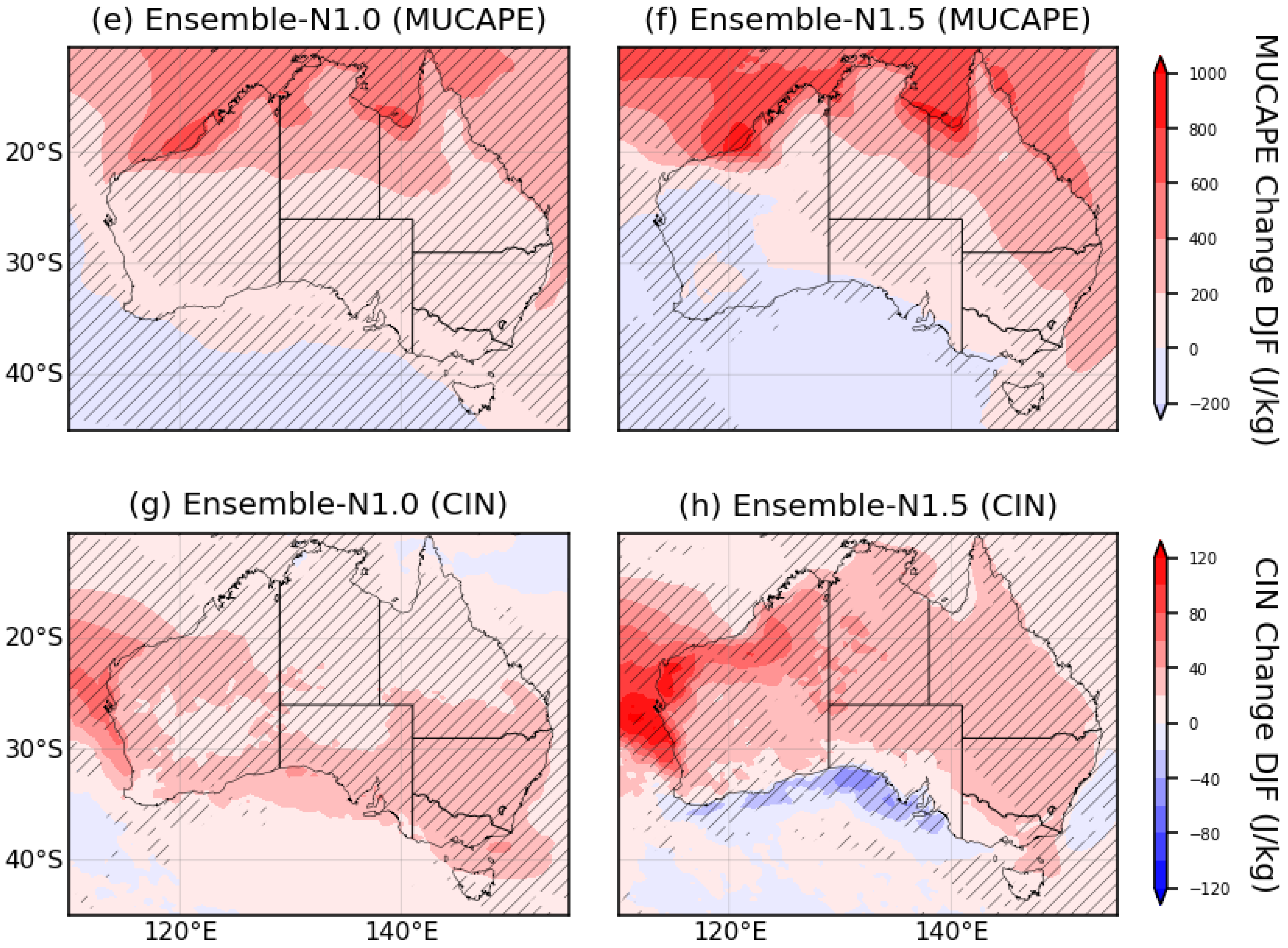
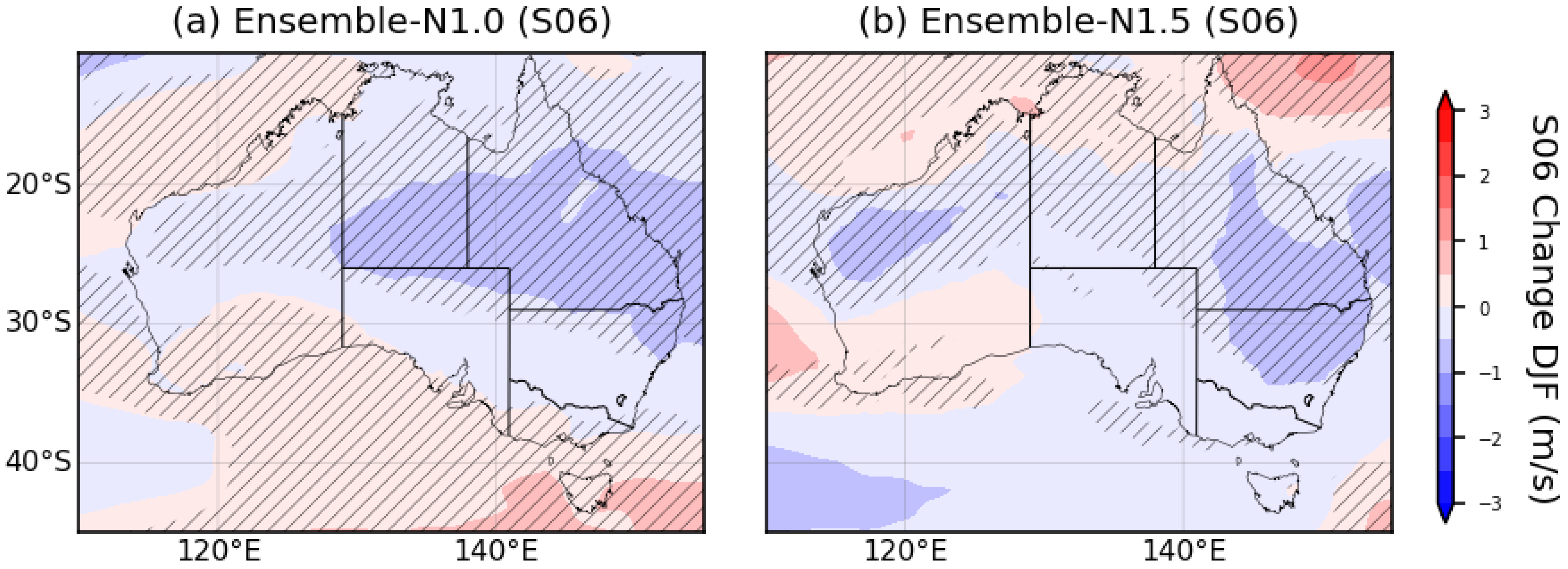


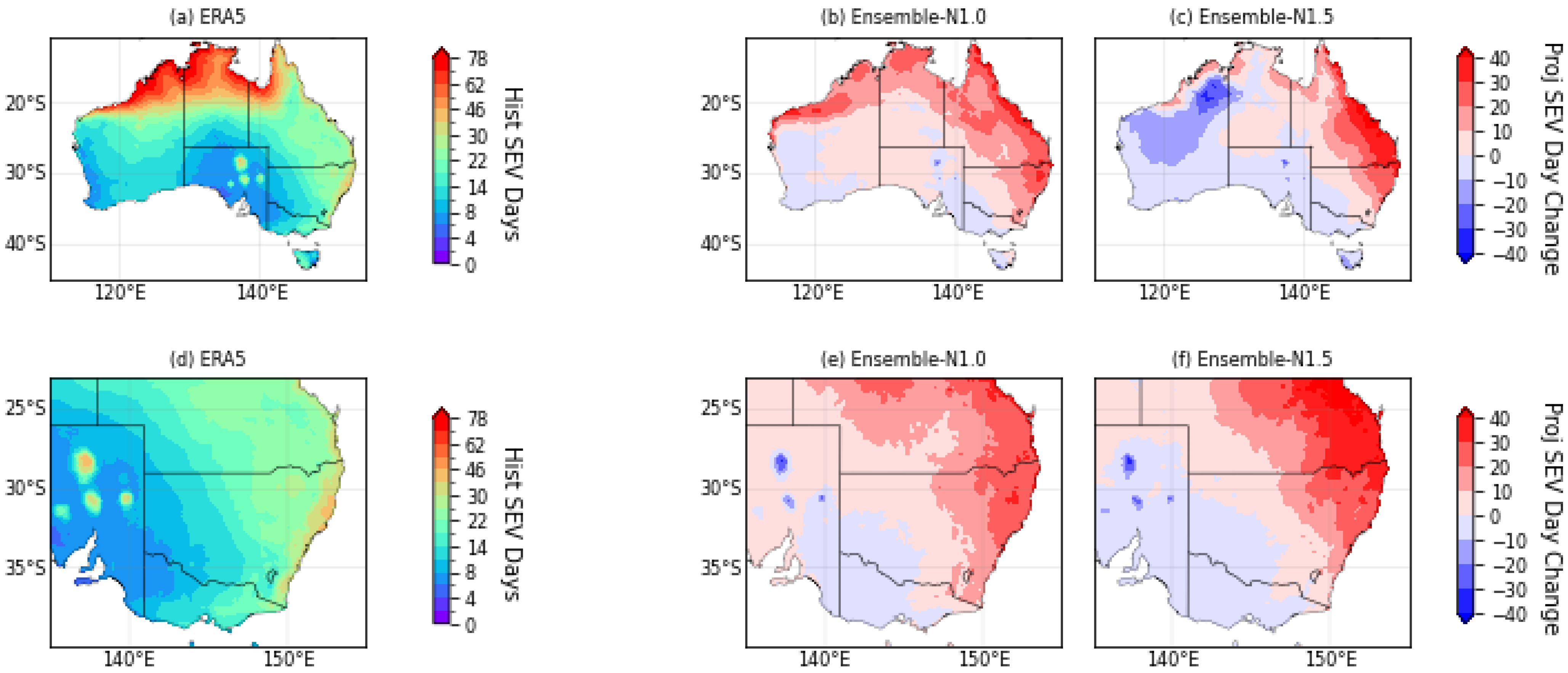
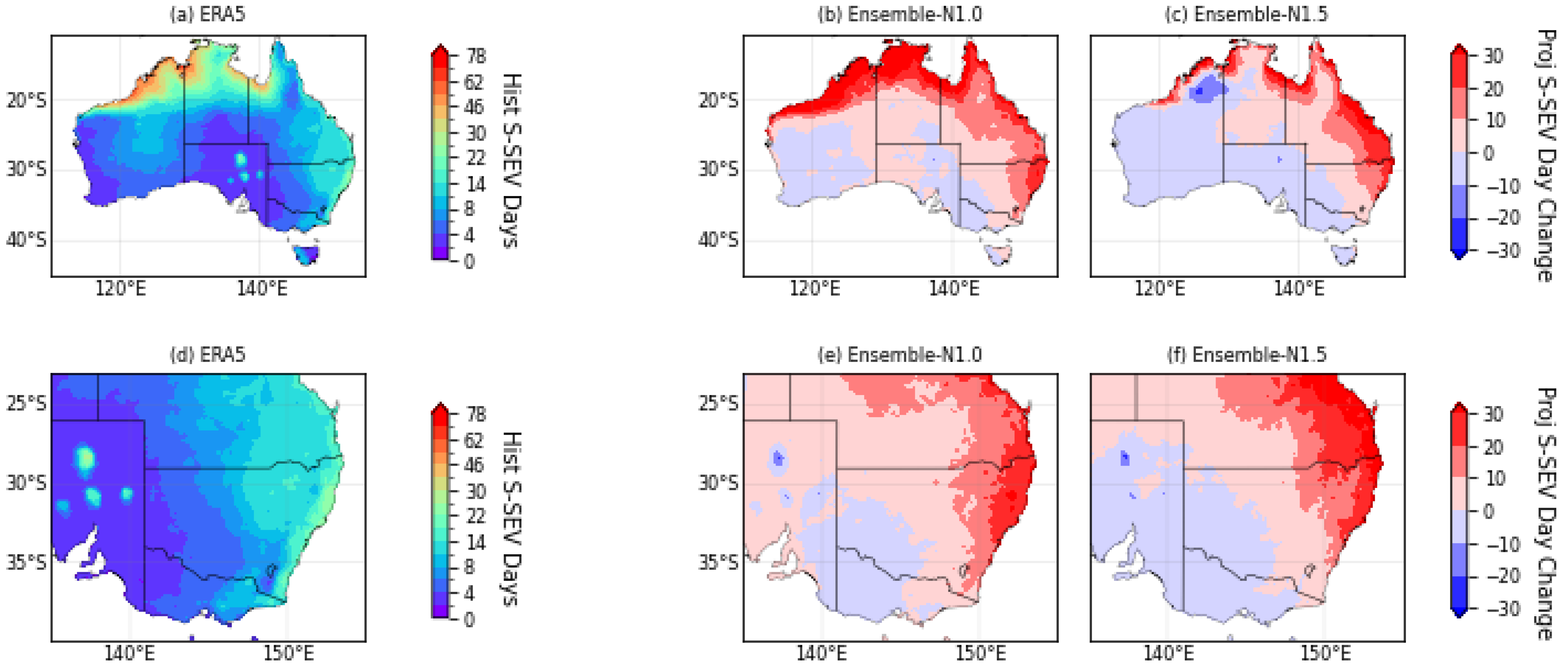
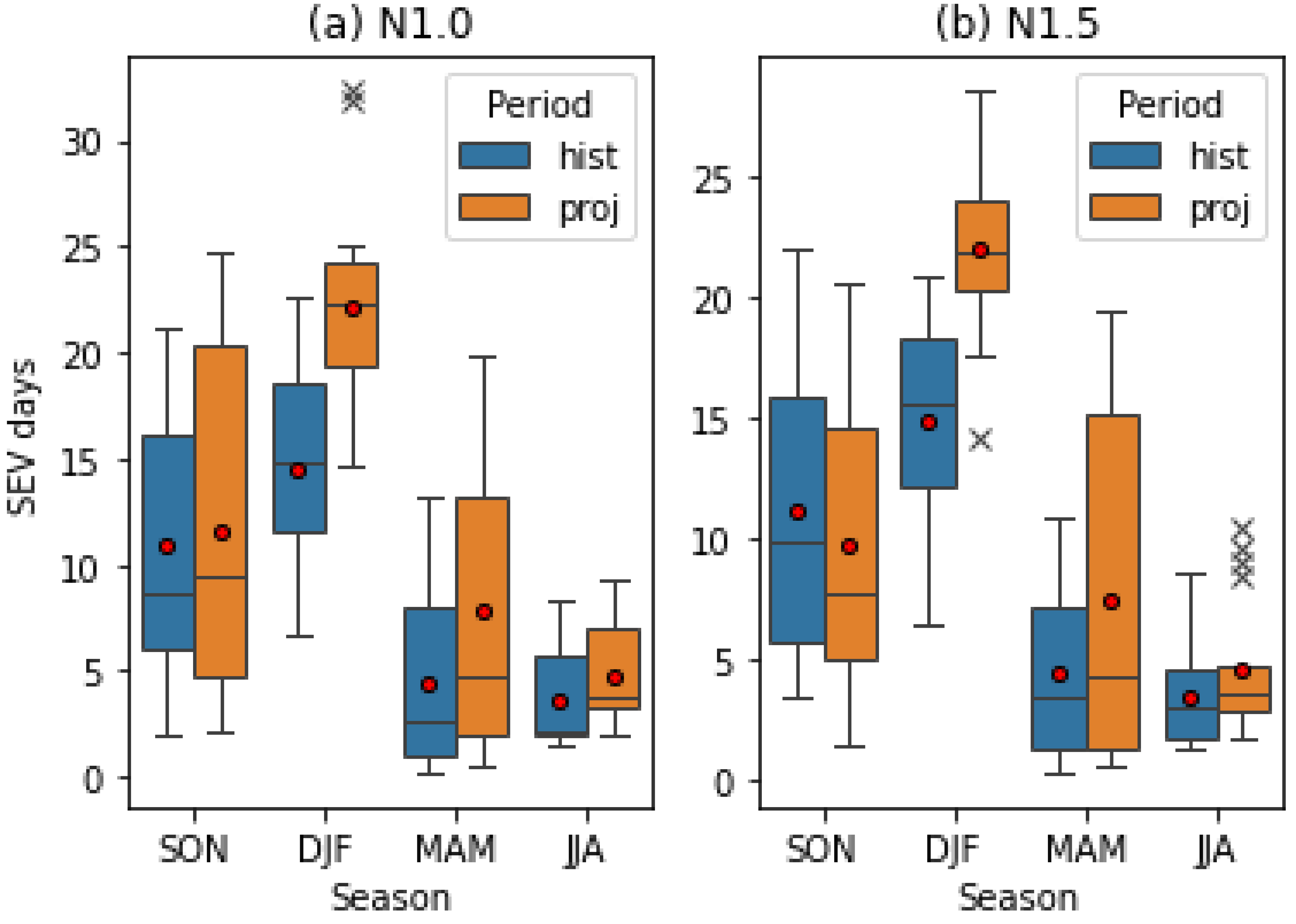

Disclaimer/Publisher’s Note: The statements, opinions and data contained in all publications are solely those of the individual author(s) and contributor(s) and not of MDPI and/or the editor(s). MDPI and/or the editor(s) disclaim responsibility for any injury to people or property resulting from any ideas, methods, instructions or products referred to in the content. |
© 2025 by the authors. Licensee MDPI, Basel, Switzerland. This article is an open access article distributed under the terms and conditions of the Creative Commons Attribution (CC BY) license (https://creativecommons.org/licenses/by/4.0/).
Share and Cite
Cheung, K.K.W.; Ji, F.; Evans, J.P.; Nishant, N.; Herold, N.; di Virgilio, G.; Beyer, K.; Riley, M.L. Projected Convective Storm Environment in the Australian Region from Two Downscaling Ensemble Systems Under the SRES-A2/RCP8.5 Scenarios. Climate 2025, 13, 229. https://doi.org/10.3390/cli13110229
Cheung KKW, Ji F, Evans JP, Nishant N, Herold N, di Virgilio G, Beyer K, Riley ML. Projected Convective Storm Environment in the Australian Region from Two Downscaling Ensemble Systems Under the SRES-A2/RCP8.5 Scenarios. Climate. 2025; 13(11):229. https://doi.org/10.3390/cli13110229
Chicago/Turabian StyleCheung, Kevin K. W., Fei Ji, Jason P. Evans, Nidhi Nishant, Nicholas Herold, Giovanni di Virgilio, Kathleen Beyer, and Matthew L. Riley. 2025. "Projected Convective Storm Environment in the Australian Region from Two Downscaling Ensemble Systems Under the SRES-A2/RCP8.5 Scenarios" Climate 13, no. 11: 229. https://doi.org/10.3390/cli13110229
APA StyleCheung, K. K. W., Ji, F., Evans, J. P., Nishant, N., Herold, N., di Virgilio, G., Beyer, K., & Riley, M. L. (2025). Projected Convective Storm Environment in the Australian Region from Two Downscaling Ensemble Systems Under the SRES-A2/RCP8.5 Scenarios. Climate, 13(11), 229. https://doi.org/10.3390/cli13110229







